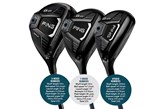Best 7-woods 2024 (and should you use one?)
Published: Last updated:
More and more tour players are putting a 7-wood into their golf bag, but should you join them? And, if so, which is the best 7-wood for your game?
2022 US Open champion Matt Fitzpatrick and Claret Jug winner Cameron Smith both have 7-woods in their bags.
So do double Major champs Dustin Johnson, Patrick Cantlay, Xander Schauffele, and Viktor Hovland…
In fact, where just five years ago only a handful of 7-woods could be found on tour, today over a quarter of pros use one – and that number’s on the rise.
Thanks to the world’s best players adopting them, any stigma associated with easy-to-launch, high-lofted fairway woods have also evaporated. But what’s behind the surge in popularity? What do the best fairway woods (and specifically 7-woods) bring to the party that hybrids don’t? And, most importantly, should you be using one too?

7-wood vs. hybrids
This story isn’t just about tour players using 7-woods. It’s about helping you identify the equipment that best benefits your game and shaves shots from your scores.
Let’s start by highlighting data from the shot trackers at Arccos, who say high-lofted fairway woods win hands down in comparison to the best hybrids.
They’ve analyzed loads of data for 0-25 handicappers and found that the greens in regulation stats with a 7-wood are 70% higher than that of a 3-hybrid; astonishing numbers when we’ve been told hybrids are the more forgiving option.
On tour, of course, the intention isn’t to just hit a green in regulation; those guys want to have the ball stopping closer to the flag on hard, fast greens, on the right tier, and below the hole. Today’s tour greens are more undulating and slicker than ever, and there are also often hazards short of the green to carry, which eliminates running shots up with a long iron.
So for the best players on the planet, 7-woods are opening up flag positions that many felt previously inaccessible. And if you’re Dustin Johnson, who says 5-woods go too far, the extra spin, height, and descent angle of a 7-wood (he even uses a 9-wood on occasion) will cover off the perfect yardage and hold faster greens.

Why 7-woods are more forgiving than hybrids
Many golfers think hybrids are easier to use than 7-woods, based mainly on the fact that the shorter shaft allows them to stand closer to the ball, which breeds confidence.
But in reality that isn’t true. Ken Oates, PGA Tour rep for Ping, told us: “The 7-wood is easier to spin, it has a higher peak height than a hybrid and it’s more consistent for right-to-left ball flights.”
The benefits don’t stop there, either. A 7-wood also has a bigger head (TaylorMade’s Stealth 7-wood is 165cc whereas the Cleveland Launcher XL, a big hybrid, is 140cc), so MOI forgiveness is significantly higher. As a result, golfers get more stability and less ball speed drop-off from off-center hits.
How the team here at Today’s golfer test golf equipment.
The numbers that show why you should consider a 7-wood
To highlight how a 7-wood, hybrid, and 3-wood compare we asked TG Test pro, Neil Wain, to hit all three (Ping G425 models). We had a launch monitor watch on, and his data shows brilliantly how each club performs in the hands of a higher-speed player.
The numbers at this speed show a decent carry difference between the 3 and 7-wood (32 yards), and once shots hit the deck there’s a 35% reduction in stopping distance with the higher loft.
At more average speeds, distances are likely to be more closely matched.
The interesting stuff shows up when comparing the 7-wood to a 4-hybrid. The 7-wood has 1.5º less loft, yet shots launched higher (1.4º), span more (1,000rpm), and peaked out three yards higher. And the ball descended onto the green at a 3.7º steeper landing angle.

Remember, this is versus a hybrid – the very club golfers have come to love for its ease of use and forgiving nature (over long irons).
The numbers spell out how a high, soft-landing ball flight has led to a spike in 7-wood adoption.
Our data shows why tour pros and higher-speed players are switching to 7-woods, but what’s the takeaway for moderate and average-speed players?
Well, the next time we’re looking at filling gaps at the top end of our bag, we’ll be exploring how high-lofted fairway woods (7, 9, and 11-woods) can fill gaps from our driver to the longest iron we hit with confidence (a 6-iron), which means considering doing away with hybrids.
If high-lofted fairways are more forgiving, higher launching, softer landing, and the data shows that we hit more greens in regulation with them, why wouldn’t we?
Which 7-woods do tour pros use?

Adam Scott, Titleist TSi2
Matt Fitzpatrick, Ping G410
Cameron Smith, Titleist TSi2
Patrick Cantlay, Titleist TSi2
Dustin Johnson, TaylorMade Stealth
Joaquin Neimann, Ping G425 Max
Viktor Hovland, Ping G425 Max
Xander Schauffele, Callaway Apex UW
Louis Oosthuizen, Ping G425 Max
Ian Poulter, Titleist TSi2
Tyrrell Hatton, Ping G425 Max
Now we’ve established why you might want to consider adding a 7-wood to your golf bag, let’s look at the best 7-woods available to buy.
Best 7-woods


You can’t buy new fairway woods without at least having a look at the TaylorMade Stealth.
The TaylorMade Stealth 7-wood is 21º in loft, and it's also available as a 24º 9-wood, should you want even higher lofts.


The Rogue ST Max 7-wood has 21º of loft and is also available in a 24º 9-wood and 27° 11-wood, while the Rogue ST Max D 7-wood has 22º of loft.


The G425 Max 7-wood has 20.5º of loft and is also available as a 23.5º 9-wood, while the Ping G425 SFT 7-wood has 22º of loft.




The Launch Pad has an offset hosel and internal draw weighting which helps mere mortals square the face at impact and lose less distance from slicing their way around the course.


More seniors and golfers who struggle for speed are likely to enjoy the shallow profile, offset hosel, and heel-side weighting.
Expect plenty of draw bias as well as a lightweight and lively feel.


The additional size brings a confidence boost to fairway wood play.
Two Glide Rails on the sole optimize strike and launch potential no matter what the lie is like.


With slightly smaller, more compact fairway heads than some, the 0211 7-wood is an absolute delight.
There’s 21º of loft and a range of cracking shaft choices when you order direct.


Three sole weights can be changed to boost forgiveness or get more draw/fade bias.
READ MORE: How to choose the right fairway wood for your game
BECOME A TODAY’S GOLFER MEMBER: Unlimited access to premium content and exclusive rewards!


